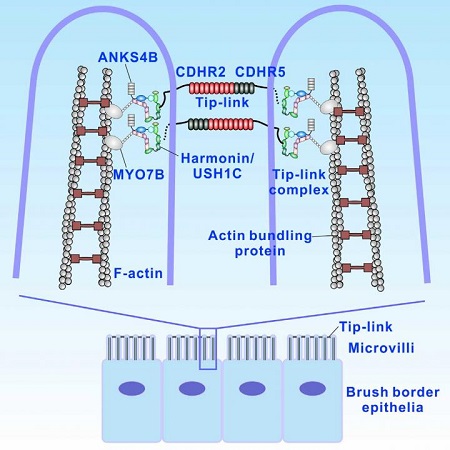Evolution likes to borrow. It can take an already-successful biological structure and alter it until it serves a new function. Two independent groups studying the proteins that organize gut microvilli now suspect that this may have been the case in the development of inner ear hair cell stereocilia. While functionally very different, the protein complexes that organize microvilli and stereocilia have striking parallels. Both papers appear January 25 in Developmental Cell.
Gut microvilli are the finger-like protrusions that line the intestines. They help the body capture nutrients that pass through the intestines. Microvilli are all about the same size and packed very tightly, adding surface area to the cells of the gut and ensuring they nab as many nutrients as possible. This organization also helps with their second job, which is to function as an active barrier against potential microbial invaders.

This visual abstract presents a systematic biochemical and structural characterization of the brush border inter-microvillar tip-link complex assembly, revealing its striking similarity with the inner ear hair cell interstereocilia complex organizations, despite their minimal overlap in proteins. Credit: Li and He et al./Developmental Cell 2016
It's known that the backbones for gut microvilli are made up of actin filaments, but what the two research groups describe in new detail is the protein complex that links these protrusions together--and how much it resembles what's been found earlier in studies of inner ear stereocilia. These structural insights are evidence that the gut and the ear are connected by evolution.
"Actin protrusions are a very common structure in the human body: most of the epithelium has this kind of structure, our airway system, our kidney structure, and even some our sensory neurons," says Mingjie Zhang, a structural biologist at the Hong Kong University of Science and Technology, and senior author of one of the papers.
"I think that the sensory systems in our hearing and our vision were most likely added on later, diverged out, from earlier structures in the gut because the basic principles of the protein components to form these structures are highly similar," Zhang says, cautioning that we still need solid proof.
Matthew Tyska, the senior author of the other paper focusing on how gut microvilli are organized, shares Zhang's theory.
"While the mechanisms that drive the formation of microvilli and stereocilia may not be identical, we always had a sense that there would be similarities in how these structures are built and organized," says Tyska, a cell and developmental biologist at the Vanderbilt University School of Medicine. "This was based on decades-old studies, which showed that when stereocilia are growing out of sensory cells, they appear to start as little microvilli. Hair cells somehow learned to take microvilli and exaggerate them and build stereocilia, and when we look at the gut system, what we're looking at may be a primordial version of the mechanosensory cells that are in the ear."
Tyska is also left wondering whether the mechanosensory abilities of hair cells have some kind of origins in the gut. A piece of evidence in support of this is a 2014 study in Nature Communications (doi: 10.1038/ncomms9871) that showed that the flow of liquid over the surface of placental epithelial cells resulted in microvillar growth. The next step will be to see whether this kind of reaction has a parallel in the gut.
For Zhang, another puzzle left to solve is why a single mutation can cause a disease as debilitating as Usher syndrome, which leads to both hearing and vision loss, while corresponding mutations in gut microvilli are less severe. If the gut is older in evolutionary time, it could be that the gut simply has had more years to develop robust backup systems.
"When you have massive amounts of genome data, it's more difficult to pinpoint what kind of mutations might lead to disease," Zhang says. "This paper provides a starting point for those who are studying gut microvilli to look for changes that will alter their functions and lead to problems."
Tyska shares this initiative, and his paper is already at work identifying how perturbation of one of the protrusion proteins, called ANKS4B, can disrupt microvilli adherence and organization. With just a little bit of a disruption, the microvilli go from looking like rows of telephone poles to fibers on a shag carpet. Even more exciting, these results mirror what is seen in the stereocilia system with genetic defects that cause Usher syndrome, further reinforcing the idea of conservation of the actin protrusion structure across different tissue types.
###
Paper 1: Developmental Cell, Li and He et al.: "Mechanistic Basis of Organization of the Harmonin/ USH1C-Mediated Brush Border Microvilli Tip-Link Complex" https://dx.
This work was supported by the Research Grants Council of Hong Kong.
Paper 2: Developmental Cell, Crawley et al.: "ANKS4B is essential for intermicrovillar adhesion complex formation" https://dx.
This work was supported by the American Heart Association, Vanderbilt University Medical Center's Digestive Disease Research Center, and the National Institutes of Health.
Developmental Cell (@Dev_Cell), published by Cell Press, is a bimonthly, cross-disciplinary journal that brings together the fields of cell biology and developmental biology. Articles provide new biological insight of cell proliferation, intracellular targeting, cell polarity, membrane traffic, cell migration, stem cell biology, chromatin regulation and function, differentiation, morphogenesis and biomechanics, and regeneration and cellular homeostasis. For more information, please visit https://www.
Source: https://www.eurekalert.org/pub_releases/2016-01/cp-des012016.php

